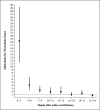Risk of a thrombotic event after the 6-week postpartum period
- PMID: 24524551
- PMCID: PMC4035479
- DOI: 10.1056/NEJMoa1311485
Risk of a thrombotic event after the 6-week postpartum period
Abstract
Background: The postpartum state is associated with a substantially increased risk of thrombosis. It is uncertain to what extent this heightened risk persists beyond the conventionally defined 6-week postpartum period.
Methods: Using claims data on all discharges from nonfederal emergency departments and acute care hospitals in California, we identified women who were hospitalized for labor and delivery between January 1, 2005, and June 30, 2010. We used validated diagnosis codes to identify a composite primary outcome of ischemic stroke, acute myocardial infarction, or venous thromboembolism. We then used conditional logistic regression to assess each patient's likelihood of a first thrombotic event during sequential 6-week periods after delivery, as compared with the corresponding 6-week period 1 year later.
Results: Among the 1,687,930 women with a first recorded delivery, 1015 had a thrombotic event (248 cases of stroke, 47 cases of myocardial infarction, and 720 cases of venous thromboembolism) in the period of 1 year plus up to 24 weeks after delivery. The risk of primary thrombotic events was markedly higher within 6 weeks after delivery than in the same period 1 year later, with 411 events versus 38 events, for an absolute risk difference of 22.1 events (95% confidence interval [CI], 19.6 to 24.6) per 100,000 deliveries and an odds ratio of 10.8 (95% CI, 7.8 to 15.1). There was also a modest but significant increase in risk during the period of 7 to 12 weeks after delivery as compared with the same period 1 year later, with 95 versus 44 events, for an absolute risk difference of 3.0 events (95% CI, 1.6 to 4.5) per 100,000 deliveries and an odds ratio of 2.2 (95% CI, 1.5 to 3.1). Risks of thrombotic events were not significantly increased beyond the first 12 weeks after delivery.
Conclusions: Among patients in our study, an elevated risk of thrombosis persisted until at least 12 weeks after delivery. However, the absolute increase in risk beyond 6 weeks after delivery was low. (Funded by the National Institute of Neurological Disorders and Stroke.).
Figures

References
-
- Bates SM, Greer IA, Middeldorp S, Veenstra DL, Prabulos AM, Vandvik PO. VTE, thrombophilia, antithrombotic therapy, and pregnancy: antithrombotic therapy and prevention of thrombosis, 9th ed: American College of Chest Physicians evidence-based clinical practice guidelines. Chest. 2012;141(Suppl):691S–736S. - PMC - PubMed
-
- James AH, Jamison MG, Biswas MS, Brancazio LR, Swamy GK, Myers ER. Acute myocardial infarction in pregnancy: a United States population-based study. Circulation. 2006;113:1564–71. - PubMed
-
- Salonen Ros H, Lichtenstein P, Bellocco R, Petersson G, Cnattingius S. Increased risks of circulatory diseases in late pregnancy and puerperium. Epidemiology. 2001;12:456–60. - PubMed
-
- Heit JA, Kobbervig CE, James AH, Petterson TM, Bailey KR, Melton LJ., III Trends in the incidence of venous thromboembolism during pregnancy or post-partum: a 30-year population-based study. Ann Intern Med. 2005;143:697–706. - PubMed
Publication types
MeSH terms
Grants and funding
LinkOut - more resources
Full Text Sources
Other Literature Sources
Medical
